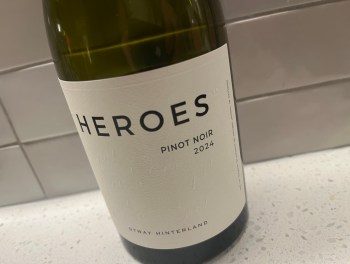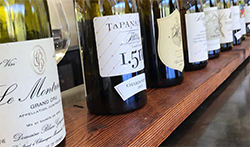Cheap Australian Chardonnay – is it dead?
It was all about Chardonnay today, with this afternoon’s National Liquor News (NLN) panel covering 22 blind Chardies at a whole spectrum of price-points.
The price-point focus is what makes this monthly tasting valuable, as the wines are grouped in blind brackets sorted by wholesale price. As a result, it’s an opportunity to taste wines up against their absolute peers, with the line-up typically covering a range of well-known small, medium and large production wine producers.
What today’s tasting showed, however, was just how far ‘budget’ Chardonnay quality has fallen. While the wines from premium brackets (over $25 RRP equivalent) were mostly very good, the brackets covering wines below that were more than disappointing – they were rubbish. More rubbish than when when the same we’ve looked at Sauvignon Blanc, Shiraz or even Cabernet Sauvignon in a similar format.
So what has happened? Why the Chardonnay fall from grace?
There is a project into Chardonnay’s popularity in Australia actually (which may be ongoing, I can’t find any evidence of a finishing date), supported by the old GWRDC (now the AGWA) and charged with studying consumer perceptions of Chardonnay.
Some of the project studies (a good one here from CSU) show that Chardonnay has been a victim of its own success really, with prices per tonne for grapes falling while plantings has increased – as seen in the figure below.
 |
| Source: Project NWG 1103 CSU (csu.edu.au) |
The reason prices per tonne have dropped is because price realisations for bottled Chardonnay have dropped, largely because supply exceeds demand.
Where it gets interesting is the possible explanations for why we’re that supply/demand relationship is now at the point where growers are offered less for Chardonnay than the cost of production ($200/tonne or less last harvest apparently).
One such factor is down to increased competition from other grapes, with Sauvignon Blanc and Pinot Gris in particular enjoying an exponential increase in popularity over the past
twenty years.
twenty years.
In turn, there was a false belief that Chardonnay’s favouritism was greater than expected, which only led to more Chardonnay plantings over the past decade, even at the expense of the grape that should have been planted, Shiraz (which is much more marketable internationally).
 |
| Source: Project NWG 1103 CSU (csu.edu.au) |
One of the studies cited in the Chardonnay Challenge project used focus groups to ascertain white wine flavour preferences, the results showing that consumers like different Chardonnay styles (including both ‘rich and oaky’ as well as ‘melon fruitiness’) as well as the lemon/lime of Riesling or tropical fruit of Sauvignon Blanc.
Or, in other words, wine drinkers want more than just one style of white wine – and more than just Chardonnay (let alone one style of Chardonnay).
Interestingly, while there is a commonly cited negative perception against Chardonnay in the media, the study also showed that consumers did not hold negative views about Chardonnay on a personal basis. In groups they picked up peer negative attitudes, but not personally.
Indeed, while Chardonnay sales are still soft, there is still plenty produced (and clearly sold). More to the point, sales of ultra premium and icon level Chardonnay are actually increasing.
So where does all this fit in the context of today’s tasting? Well, for one, it explains quite a bit of the sameness found in the cheaper wines. With demand sinking and bottle prices driven down, winemakers are forced to reduce the costs of production. That all starts with grape prices to growers and flows on from there. Unlike the unoaked styles – like Sauvignon Blanc and Pinot Gris – Chardonnay needs more ‘winemaking’ and more maturation, which makes it more expensive to produce. In turn the way to cut costs it to move to lower quality oak (chips and staves are cheaper than barrels), less attentive winemaking (to lower winemaking labour costs) and shorter maturation periods (again cheaper, particularly from a taxation point of view).
All this ultimately results in fewer complex wines made cheaper and with less care – in other words, lesser quality.
Unsurprisingly, that was on show in the cheaper wines tasted at today’s tasting, with a noticeable move away from oak influence and into a more ‘fruity’ style.
Speaking of style, all that aforementioned confusion about different Chardonnay flavours and the rise of Gris and Sauvignon Blanc only pushes winemakers away from traditional richer oaky styles, further perpetuating the simple fruity style.
Fitting nicely in with the increase in premium Chardonnay sales was the small handful of premium wines also included in today’s lineup. Wines that have demand, have loyal customers who appreciate a known style and receive strong prices. Wines like the 2013 Devils Lair Chardonnay, which looked very handy even for a warmer, red wine friendly vintage in WA. Ditto the 13 Vasse Felix Chardonnay, which was very good too.
But getting back to the point, where does that leave cheaper Chardonnay?
Well, there is an argument – perpetuated by articles like this – that Australia can’t afford to be making cheap wine like that. From an environmental point of view, wine that is cheaper than water is a ridiculous circumstance in a nation as dry as ours, particularly given that it can take between 2-10 litres of water to make a litre of wine.
Yet is that really the answer? Is giving up on cheap Chardonnay the only way? Is cheap Australian Chardonnay dead?
Help keep this site paywall free – donate here





4 Comments
Hello Andrew,
This is why I am a regular reader and sometimes novice contributor……if its crap you say so and with balance . If it is at the other end of the quality spectrum you provide an equally balanced opinion.
You dont publish a big fat review book annually with all Australian wines 92+, you call it as you see it, taste it and smell it.
You keep writing the way you do and I'll keep reading…….and sometimes contributing.
Kudos to you sir
Colin r
Feel free to contribute more Colin – appreciate it!
I buy some Fiano from Ricca Terra Farms in the Riverland and they have been pulling out their Chardonnay to plant more Fiano. At 1100 per tonne for Fiano and 250 per tonne for Chardonnay it is a no brainer for the grower.
Josh Tuckfield
I would be too.